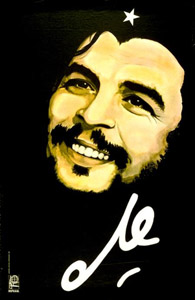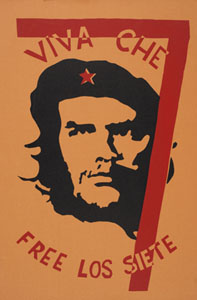Review/Reseña in A
Contracorriente | Vol. 7, No. 1. Autumn 2009

Michael Casey, Che's Afterlife: The Legacy of an Image. New York: Vintage Books, 2009.
Can
icons be owned?
The curious case of Che Guevara’s
image
Review by Lincoln Cushing
Hanging in my living room is a
photograph of Fidel Castro and Camilo Cienfuegos, sublimely capturing
the spirit of the triumphant guerrillas entering Havana on January 8,
1959. It’s signed to my parents from Fidel during his 1959 Washington,
D.C. visit, in appreciation for my father’s role
in helping set up Castro’s Sierra Maestra interview with New York
Times correspondent Herb Matthews. But aside from its considerable
personal significance, I always felt that photo was an iconic image of
the revolution itself, representing something bigger than just that
moment.
It wasn’t until I read Che’s Afterlife that I learned this
photograph was taken by Luis Korda, business partner of Alberto Korda,
and is part of the complex story of branding the Cuban revolution.
Alberto Korda, of course, is the photographer responsible for the image
behind the iconic image of Che Guevara. Branding is the accurate but
perhaps distasteful word for instilling positive values about something
(a product – Nike’s “Do it”, a labor union – the United Farm Workers’
“Sí se puede!”, a revolution – Cuba’s “¡Hasta la victoria, siempre!”)
in the consciousness of the broad public. Just as the term “propaganda”
is seen as neutral or even positive in the eyes of leftists, “branding”
is just the commercial world’s version of the
same thing.
commercial world’s version of the
same thing.
Casey gives us a thorough history of the photograph that started the worldwide image known as “Che”, one of two snapped by Alberto Korda on March 5, 1960 and often referred to as “the Guerrillero Heroico.” He traces Korda’s personal and professional life. In 1956 Alberto Díaz Gutiérrez and his friend Luis Pierce started a photography studio in Havana, naming it after the deceased Hungarian film director Alexander Korda. Before long the two were referred to as Luis and Alberto Korda. Like a good journalist should, Casey presents the story everyone thinks they know, then digs deeper and tells us how sometimes that just isn’t exactly right.
Casey also outlines Che’s life, and how it eventually took on worldwide resonance. Che’s role in the state-building period after the Cuban armed struggle was sometimes exemplary and sometimes problematic, especially for a small revolutionary government struggling to survive in a Cold War world. As an archivist, I was saddened to hear the story of how Korda’s entire professional collection was “nationalized” in 1968 and most of the photographs, many of them candid images of Fidel Castro, destroyed. The thorny issue of personal ownership of national cultural assets is a legitimate one for debate, but the evidence is that this particular case was handled poorly and clumsily. But as the book reveals later, mere state ownership did not translate into permanent state intellectual property rights.
Perhaps most significantly, this book examines the circumstances under which Korda’s photo became one of the most recognized political graphic icons of the 20th century, and the verdict is still out about the 21st. Casey goes into great detail on how the photo was transformed into a graphic image – and it was the various versions of the stylized image, not the photograph itself, that ultimately became iconic. UCLA art historian David Kunzle offered the first academic exploration of this artistic evolution, which he calls the “Korda matrix,” in his lavishly illustrated 1997 title Che Guevara: Icon, Myth, and Message. Casey also documents the enormous ideological and geographical range that has embraced Che’s face, from the purely apolitical to Nazi skinheads to militant peasants. It turns out that the tent of Che’s spirit is immensely large.
It’s this component of the book that I found particularly fascinating, because it involves the complex interconnection between copyright law, political ethics, political zeal, and the cold marketplace.
For years, starting in 1968, it seemed that Che’s visage appeared everywhere. This was certainly the case on the Left, where he was summoned as revolutionary shorthand just like the peace symbol, the red star, or the clenched fist. The details of the image’s origin didn’t matter – Che was seen as being safely in the public domain, as long as he was used respectfully and correctly. And even then, opportunistic merchants and advertisers ran with it, leeching off of the vibrant counterculture in the way they do so well. All that changed in 2001, when Alberto Korda sued Smirnoff Vodka’s advertising agency for using the image in a magazine spread. The mighty corporate world was busted by the spunky Cuban photographer, upsetting their evil plan to propagandize about the demon alcohol which Che never drank. Settling out of court, Korda affirmed his copyright to the image, donating the fees to Cuban health care. Later that year Korda died.
But wait – how could Korda hold
copyright? Didn’t postrevolutionary Cuba reject such capitalist
notions? Well, yes, it did, until 1997, when it signed the Berne
Convention for the Protection of Literary and Artistic Works. This was
part of a process in which Cuba had begun normalizing trade relations
with the rest of the world, and the consequences of such a step were
monumental for Cuban cultural workers.
cultural workers.
Although only quoted once in Casey’s book, someone who’s written an excellent analysis of this issue is Ariana Hernández-Reguant. Her “Copyrighting Che: Art and Authorship under Cuban Late Socialism” (Public Culture, 2004) laid out the tremendous social and economic contradictions that have emerged as a result of this policy shift. As she puts it,
The issue of copyrights was a thorny one because it revealed the most fundamental differences between socialism and capitalism regarding labor, private property and its accumulation, individual rights, and social equality. Socialist countries recognized moral rights to authorship but not economic rights beyond wages.
In Cuba, the re-recognition of copyright has created a dichotomy between cultural workers that produce a product (painters, poets, songwriters, and yes, photographers) as opposed to cultural workers that just perform. No matter how talented or dedicated, a dancer will never get royalties for her work. In an economy which has struggled through many challenges over the years, such a distinction can mean the difference between living well or living marginally. Add this factor to other economic inequalities (e.g., working for a foreign business versus a state job) and it becomes clear that the stakes are very high for protecting cultural rights.
Compounding the situation is
that Cuba has an interest in its public image, as any nation does. And
the icon of Che has become irreconcilably linked with Cuba’s
revolutionary status. It is in the interests of the Cuban government to
continue the broadcast of Che’s image within the constraints of
international law. So the current stage of the saga is one of absolute
image control. In 2002, the Korda estate, administered through his
daughter Diana Lopez Díaz, began selling exclusive licenses for all Che
products. All of a sudden, the long arm of the law was pressuring
vendors to pay huge fees or be sued. Many of them were
socially-responsible businesspeople like Scott Cramer of
Minneapolis-based Northern Sun Merchandising, who gave up negotiating
for permission on a shirt he’d sold for years. He tried switching to
another, non-Korda Che image, but it just didn’t have the selling power
of the original. So Cramer sucked it up and is now a legally licensed
Che shirt vendor – selling shirts made by an offshore manufacturer
prescribed by the licensor, whom he has to just trust is not a
environmentally-polluting sweatshop. Even Che paraphernalia in Havana,
a staple for street merchants, has vanished. Although the bulk of
profits (after legal fees, of course) ostensibly goes to a community
center in Havana, the damage has been done. The once-ubiquitous symbol
of revolutionary spirit has been reduced to a commercial asset, “U.S.
GATT visual aid copyright number VA-1-276-975.”
For years, I have defended artistic authorship when I see it exploited.
In several incidents I politely notified high profile U.S. poster
makers who had taken liberties with the political works of “anonymous”
Cuban designers that what they were doing was disrespectful, and in
each case royalties were paid to the artists or their estates. But
these involved specific graphic images created by a single artist. A
case can be made that the Che image, though based on a specific
photograph, has been so widely disseminated and adapted that it has
irretrievably entered a form of public domain protection. It is this
question, this political and artistic conundrum, that is explored in
Casey’s book, and there’s plenty of material to chew on.
But it’s not all gloom and doom. Casey ends his book with this optimistic long view of Che’s image:
Its appeal…lies in its spirituality, in its ability to feed people’s longings for a better world and to encourage them to dream of defeating death. It helps them confront that sinister force, whatever shape it takes for them – military dictatorship; a CEO slashing jobs; an offense against their religion; their sexuality; or their favorite TV channel; or a flooding drainage canal. Against these real and imagined threats, Korda’s Che keeps hope alive.
Yes, “¡Hasta la Victoria, siempre!”
Images used in this
review:
"Che," 1982, for OSPAAAL,
Havana, Cuba; by Rafael Enriquez, 1982. Collection of Lincoln Cushing.
"Viva Che : Free Los Siete," for the Los Siete de la Raza Defense
Committee (San Francisco, CA), artist unknown, 1970. AOUON Archive,
Berkeley.
Also see- "Guerrillero
Heróico"
Return to Docs Populi / Documents
for the Public
updated 4/23/2021